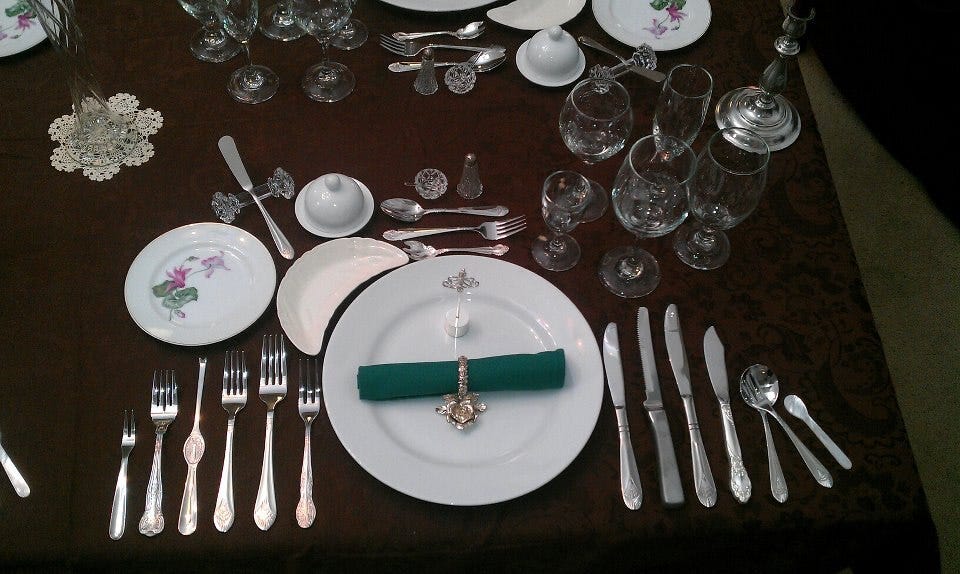Teaching Etiquette at a Think Tank
Even in the informal culture of contemporary America, manners still matter

I’m not sure when I and two colleagues at the American Enterprise Institute started an etiquette seminar for research assistants and interns. As a poll watcher, I was writing about the first poll on presidential greatness, published in 1948 by Harvard historian Arthur Schlesinger, Sr. While doing the research, I stumbled across a book he had written called “Learning How to Behave: A Historical Study of American Etiquette Books.” Intrigued, I read in one sitting the slim 71-page volume that traced four waves of American etiquette.
I thought AEI’s research assistants and interns would be interested in this history, and a colleague suggested adding a demonstration on contemporary dinner-table place settings and a discussion of wine. Thus the seminar and practicum were born. Not only were we interested in how this group of smart young people would react, but we also hoped to learn more about the new world of contemporary manners from them.
There are no hard data of which I’m aware on the state of manners in America, but there is a widespread, long-standing conviction among Americans that things are getting worse. In a 1999 ABC News poll, 73% said that compared to 20 or 30 years ago, most Americans’ manners were worse; only 5% said they were better. In a 2010 Fox News poll, 65% of registered voters reported that they heard more foul language than in the past. Some of this is nostalgia, of course, but these poll findings and others suggest that the public worries about the fraying social fabric, and manners are an especially visible instance of that fraying. Caring about how we treat one another at the dinner table, at work, on the road and on the campaign trail is important, as Schlesinger understood.
Schlesinger describes the books Americans originally turned to and notes that the early “courtesy” books were usually of British or French rather than American origin. This was true for several reasons: Americans were too busy “taming the wilderness” to write their own etiquette manuals, so they relied on imports from Britain and France. The colonies were settled by many people in the lower classes with few traditions of polite behavior, so they felt they needed the life lessons provided by these books. Further, Schlesinger reminds us that women, the usual stewards of decorum, were largely absent in the nation’s early history. As more arrived, etiquette books became popular guides for them and their suitors and families. Finally, he says, immigrants were arriving and wanted to learn and master the manners of English speakers.
Other resources for AEI’s etiquette seminar included “Star-Spangled Manners” by Judith Martin—otherwise known as Miss Manners—on how the Founders fashioned what she calls “America’s egalitarian etiquette.” George Washington, she wrote, was deeply interested in setting standards befitting the new nation. Thomas Jefferson was not fastidious about manners at table but was adamant about another form of etiquette, the rules of parliamentary procedure. Benjamin Franklin, she says, taught the young that good manners could, in addition to being the right thing to do, also advance one’s career.
As America became more self-confident with its westward expansion, Schlesinger writes, etiquette books of American origin appeared. Then, with the emergence of the great fortunes in the late 19th century, the wealthy new upper classes turned back to British or French books for guidance. The fourth stage of American etiquette began with the backlash against this great wealth and the growing independence of women, who found other pursuits more interesting than rules of the table. Standards were relaxed, but new books kept coming.
In the period of social flux after World War I, Emily Post’s empire was born with the publication of her 1922 book “Etiquette: The Blue Book of Social Usage.” Over time, Post resigned herself to the new, less formal rules. Schlesinger writes that the original Post volume contained a chapter titled “Chaperons and Other Conventions.” In a subsequent edition, it became “The Vanishing Chaperone and Other Conventions.” Casual manners overtook formality.
This historical progression of etiquette practices appeared to interest the young people at AEI, but now it was time to provide them some lessons about daily life. So what did the AEI practicum entail? One of my colleagues discussed some rules of email etiquette (e.g., don’t call someone you are writing to by their first name before you know them or have been given permission to use a first name). AEI’s banquet manager talked about how to order wine (smelling the cork indicates you don’t know much about wine, so don’t do it), and he helpfully provided a list of inexpensive wines for young people. We used an actual formal place setting and provided flatware and an array of goblets (the lesson here is to use them from the outside in).
We also provided guidance on how to have a dinner party (make at least one dish yourself) and urged our pupils to start hosting them. We asked them to think about how they would behave at a luncheon or dinner with a prospective employer or with their partner’s family (think carefully about ordering a drink). We urged them to shift their attention to the person on their left and right with each course so that no one feels excluded. Hand-written thank-you notes are preferred, but email will do today in many cases. We impressed upon them that etiquette wasn’t about proper place settings, but about treating people with courtesy and respect.
As Schlesinger wrote, etiquette is always evolving, and it is important to introduce new generations to the history of this “functional trait of civilization” as well as its basic rules. Now, if only I could get my stepchildren not to bring their phones to the table.



